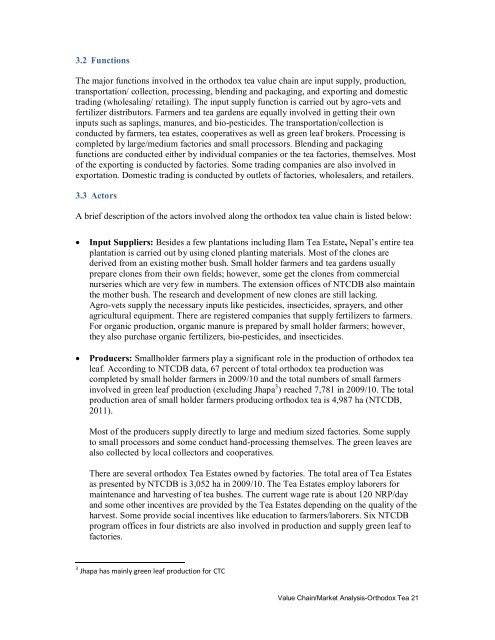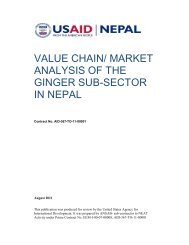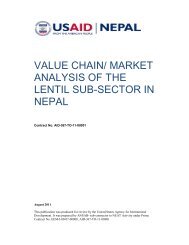value chain/ market analysis of the orthodox tea sub ... - Nepal Trade
value chain/ market analysis of the orthodox tea sub ... - Nepal Trade
value chain/ market analysis of the orthodox tea sub ... - Nepal Trade
You also want an ePaper? Increase the reach of your titles
YUMPU automatically turns print PDFs into web optimized ePapers that Google loves.
3.2 FunctionsThe major functions involved in <strong>the</strong> <strong>orthodox</strong> <strong>tea</strong> <strong>value</strong> <strong>chain</strong> are input supply, production,transportation/ collection, processing, blending and packaging, and exporting and domestictrading (wholesaling/ retailing). The input supply function is carried out by agro-vets andfertilizer distributors. Farmers and <strong>tea</strong> gardens are equally involved in getting <strong>the</strong>ir owninputs such as saplings, manures, and bio-pesticides. The transportation/collection isconducted by farmers, <strong>tea</strong> estates, cooperatives as well as green leaf brokers. Processing iscompleted by large/medium factories and small processors. Blending and packagingfunctions are conducted ei<strong>the</strong>r by individual companies or <strong>the</strong> <strong>tea</strong> factories, <strong>the</strong>mselves. Most<strong>of</strong> <strong>the</strong> exporting is conducted by factories. Some trading companies are also involved inexportation. Domestic trading is conducted by outlets <strong>of</strong> factories, wholesalers, and retailers.3.3 ActorsA brief description <strong>of</strong> <strong>the</strong> actors involved along <strong>the</strong> <strong>orthodox</strong> <strong>tea</strong> <strong>value</strong> <strong>chain</strong> is listed below:· Input Suppliers: Besides a few plantations including Ilam Tea Estate, <strong>Nepal</strong>s entire <strong>tea</strong>plantation is carried out by using cloned planting materials. Most <strong>of</strong> <strong>the</strong> clones arederived from an existing mo<strong>the</strong>r bush. Small holder farmers and <strong>tea</strong> gardens usuallyprepare clones from <strong>the</strong>ir own fields; however, some get <strong>the</strong> clones from commercialnurseries which are very few in numbers. The extension <strong>of</strong>fices <strong>of</strong> NTCDB also maintain<strong>the</strong> mo<strong>the</strong>r bush. The research and development <strong>of</strong> new clones are still lacking.Agro-vets supply <strong>the</strong> necessary inputs like pesticides, insecticides, sprayers, and o<strong>the</strong>ragricultural equipment. There are registered companies that supply fertilizers to farmers.For organic production, organic manure is prepared by small holder farmers; however,<strong>the</strong>y also purchase organic fertilizers, bio-pesticides, and insecticides.· Producers: Smallholder farmers play a significant role in <strong>the</strong> production <strong>of</strong> <strong>orthodox</strong> <strong>tea</strong>leaf. According to NTCDB data, 67 percent <strong>of</strong> total <strong>orthodox</strong> <strong>tea</strong> production wascompleted by small holder farmers in 2009/10 and <strong>the</strong> total numbers <strong>of</strong> small farmersinvolved in green leaf production (excluding Jhapa 3 ) reached 7,781 in 2009/10. The totalproduction area <strong>of</strong> small holder farmers producing <strong>orthodox</strong> <strong>tea</strong> is 4,987 ha (NTCDB,2011).Most <strong>of</strong> <strong>the</strong> producers supply directly to large and medium sized factories. Some supplyto small processors and some conduct hand-processing <strong>the</strong>mselves. The green leaves arealso collected by local collectors and cooperatives.There are several <strong>orthodox</strong> Tea Estates owned by factories. The total area <strong>of</strong> Tea Estatesas presented by NTCDB is 3,052 ha in 2009/10. The Tea Estates employ laborers formaintenance and harvesting <strong>of</strong> <strong>tea</strong> bushes. The current wage rate is about 120 NRP/dayand some o<strong>the</strong>r incentives are provided by <strong>the</strong> Tea Estates depending on <strong>the</strong> quality <strong>of</strong> <strong>the</strong>harvest. Some provide social incentives like education to farmers/laborers. Six NTCDBprogram <strong>of</strong>fices in four districts are also involved in production and supply green leaf t<strong>of</strong>actories.3 Jhapa has mainly green leaf production for CTCValue Chain/Market Analysis-Orthodox Tea 21






